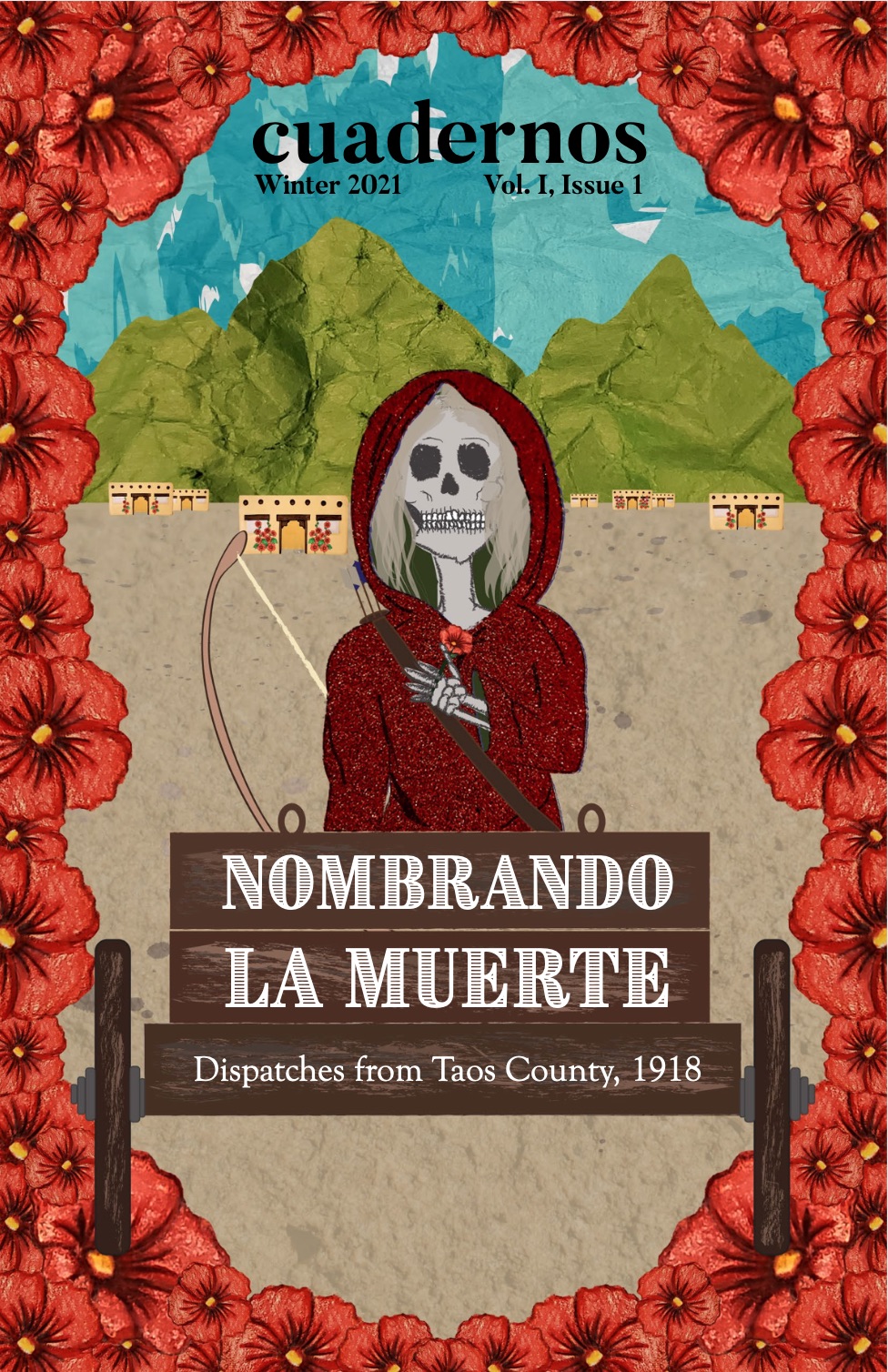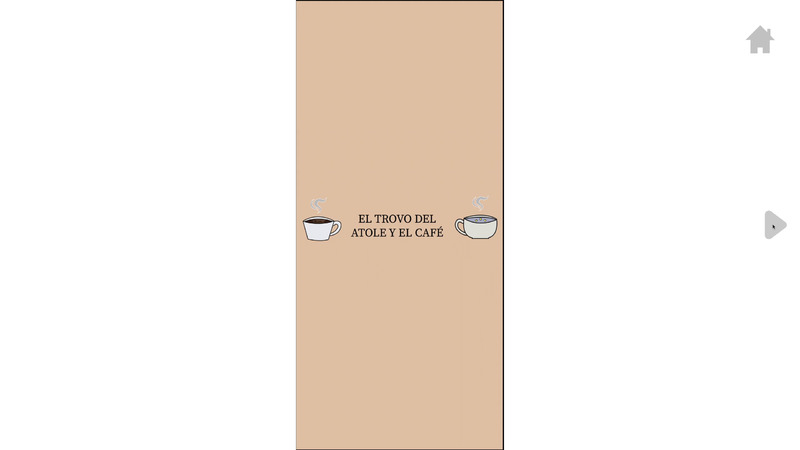New Mexico’s Center for Cultural Technology (CCT) is an educational, community engagement, and R&D partnership between the Department of Media Arts & Technology at New Mexico Highlands University and the New Mexico Department of Cultural Affairs. CCT’s mission is to cultivate a homegrown talent pool of multimedia specialists capable of working with cultural content and committed to serving their communities.
Since 2005, CCT has placed over 200 cultural technology interns in museums, libraries, historic sites, and parks across New Mexico and the southwest, creating well over 300 projects in video/audio, exhibits, graphic design, mobile apps, web sites, and more. CCT’s main headquarters is in the Department of Media Arts & Technology, located in the McCaffrey Historic Trolley Building on the campus of New Mexico Highlands University in Las Vegas, NM.
-
Manitos PersonasManitos Personas
-
Cafe y AtoleThere are two published versions of El Trovo del Atole y el Café, one by José de Jesús López and one by an unknown or anonymous author. The one here is a third version and is unpublished. It was written by Elva Vigil Valdez of Capulin, Colorado. In it, while Atole defeats Coffee, Atole invokes the sentiment of reconciliation and also leaves open the possibility of continuing the dialogue in the future. The bilingual graphics in comic book format were created in 2020 by Natasha Vasquez, design intern from New Mexico Highlands University. She envisioned a conversation between a grandmother and her grandson, which morphs into a dialogue between coffee and atole. The recorded performance is by David Garcia and Thelma Argüello. According to information provided by folklorist Enrique Lamadrid for Folk Music of Hispanic New Mexico: The John Donald Robb Collection, traditionally trovos are musical duels in improvised verse between two trovadores (troubadors). Originating in the courts of medieval Spain and Portugal where topics centered on such lofty themes as theological arguments, trovos migrated to the Canary Islands and were popularized in the Americas throughout parts of Mexico, the Caribbean, and beyond, including New Mexico and Colorado. They were often performed for travelers along the Camino Real and the Old Spanish Trail to California. According to information provided by Estevan Rael-Galvez, trovos are often a form of political protest, addressing contemporary issues creatively. El Trovo del Atole y el Café is one of the most interesting from nineteenth-century New Mexico -– a battle of wits between a cup of coffee and a cup of atole, a traditional Mexican hot beverage made from masa. One interpretation proposed by Dr. Lamadrid could be What are the virtues of coffee versus atole? What is more valuable, oil or water? But according to Dr. Rael-Galvez it could also be interpreted as a critique of capitalism and colonial imposition, juxtaposing coffee as elite, foreign, and urban with atole as Indigenous, rural, and of the people.
-
Manitos Personas PlacematsThese downloadable placemats were designed by interns from the Manitos Community Memory Project under the direction of Dr. Estevan Rael-Galvez. They were produced in conjunction with a series of posters called Manitos Personas that honor tradition bearers and others who serve the community and help to hold it together. The original idea, inspired by a project of community scholar and activist Dr. Patricia Trujillo, was to distribute the placemats to local restaurants to educate and inform children about their Manito heritage. As the placemats were in production, however, COVID-19 hit, and restaurants closed. Schools were desperate for ways to keep their students engaged while learning from home. The placemats were printed and sent home through distributions at school sites along with food and other educational materials and supplies. We also discovered that adults enjoyed the activities on placemats and so there were a number of distributions at senior centers.
-
Manitos Cuaderno SeriesThe year 2020 was defined by the COVID-19 pandemic, which decimated families and communities in northern New Mexico and southern Colorado where many heirs to the unique Indo-Hispano culture often refer to themselves as Manitos. In response, the Manitos Community Memory Project (MCMP), with support from the American Recovery Act, National Endowment for the Humanities, initiated a series of publications to help Manitos address the trauma of the pandemic through connection to their history, cultural heritage, and to each other. The format of the publications pays homage to the cuadernos, small journals or notebooks, traditionally used by Manitos to record all kinds of information. The Manitos Community Memory Project (MCMP) was initiated in January 2019 with funding from the Andrew W. Mellon Foundation through a grant to the Center for Cultural Technology, a partnership between the Department of Media Arts and Technology at New Mexico Highlands University in Las Vegas, New Mexico, and the New Mexico Department of Cultural Affairs, working in collaboration with the New Mexico Humanities Council and a network of Manito community partners and academic researchers. The shared vision is to protect and preserve the region's at-risk cultural heritage by creating a network of memory gathering sites located in rural libraries, schools, and non-profit organizations, and by building a sustainable digital archive by and for Manitos. The original focus of the MCMP was on healing from historical trauma, passed down from generation to generation, and recovery from the legacy of colonialism. The COVID-19 pandemic expanded the focus to address a new trauma. The Manitos Cuaderno Series was one of a number of MCMP internship projects designed to demonstrate the value of a community-directed digital cultural heritage repository. Initially envisioned as a series of downloadable digital publications, it was Ellen Dornan, former director of digital initiatives at the New Mexico Humanities Council, who had the vision that they should be printed and distributed free of charge and found the funding to make it happen. In January 2021 the printed sets of Volume I made their debut. In 2023 Volume II was published.
-
Pride: How it Affects Historical Perspectives by Weston Gabriel Lucas ArchuletaWeston uses his own complicated family history to illustrate how pride affects memory and who and what is remembered or forgotten.
-
Hope and Faith Memoirs of a Mother/Esperanza y Fe Memorias de una Madre by Alma RiveraThis piece is dedicated to all parents, from all generations, who have struggled with depression and yet found a way and the courage to live for their children! This 4 minute short film was created by Alma Rivera, in honor of motherhood. Navigating the journey between heart break and healing, a mother shares her vulnerable experience in hopes to help others. Maybe my story could help another mother who was in need of support and encouragement. No estás solo y hay ayuda disponible Comadres! You are not alone and help is out there Co-mothers!
-
Good Mourning by Holly LovejoyA glimpse of real time grief from losing an adult child to substance abuse.
-
Manitos Personas - MayordomaManitos Personas - Mayordoma
-
Manitos Personas - MaestroManitos Personas - Maestro
-
Manitos Personas - CuranderaManitos Personas - Curandera
-
Manitos Personas - AbuelosManitos Personas - Abuelos
-
Cafe y Atole, spanishEl Trovo del Atole y el Café/The Trovo of Atole and Café. There are two published versions of El Trovo del Atole y el Café, one by José de Jesús López and one by an unknown or anonymous author. The one here is a third version and is unpublished. It was written by Elva Vigil Valdez of Capulin, Colorado. In it, while Atole defeats Coffee, Atole invokes the sentiment of reconciliation and also leaves open the possibility of continuing the dialogue in the future. The bilingual graphics in comic book format were created in 2020 by Natasha Vasquez, design intern from New Mexico Highlands University. She envisioned a conversation between a grandmother and her grandson, which morphs into a dialogue between coffee and atole. The recorded performance is by David Garcia and Thelma Argüello. According to information provided by folklorist Enrique Lamadrid for Folk Music of Hispanic New Mexico: The John Donald Robb Collection, traditionally trovos are musical duels in improvised verse between two trovadores (troubadors). Originating in the courts of medieval Spain and Portugal where topics centered on such lofty themes as theological arguments, trovos migrated to the Canary Islands and were popularized in the Americas throughout parts of Mexico, the Caribbean, and beyond, including New Mexico and Colorado. They were often performed for travelers along the Camino Real and the Old Spanish Trail to California. According to information provided by Estevan Rael-Galvez, trovos are often a form of political protest, addressing contemporary issues creatively. El Trovo del Atole y el Café is one of the most interesting from nineteenth-century New Mexico -– a battle of wits between a cup of coffee and a cup of atole, a traditional Mexican hot beverage made from masa. One interpretation proposed by Dr. Lamadrid could be What are the virtues of coffee versus atole? What is more valuable, oil or water? But according to Dr. Rael-Galvez it could also be interpreted as a critique of capitalism and colonial imposition, juxtaposing coffee as elite, foreign, and urban with atole as Indigenous, rural, and of the people.
-
Cafe y Atole, englishEl Trovo del Atole y el Café/The Trovo of Atole and Café. There are two published versions of El Trovo del Atole y el Café, one by José de Jesús López and one by an unknown or anonymous author. The one here is a third version and is unpublished. It was written by Elva Vigil Valdez of Capulin, Colorado. In it, while Atole defeats Coffee, Atole invokes the sentiment of reconciliation and also leaves open the possibility of continuing the dialogue in the future. The bilingual graphics in comic book format were created in 2020 by Natasha Vasquez, design intern from New Mexico Highlands University. She envisioned a conversation between a grandmother and her grandson, which morphs into a dialogue between coffee and atole. The recorded performance is by David Garcia and Thelma Argüello. According to information provided by folklorist Enrique Lamadrid for Folk Music of Hispanic New Mexico: The John Donald Robb Collection, traditionally trovos are musical duels in improvised verse between two trovadores (troubadors). Originating in the courts of medieval Spain and Portugal where topics centered on such lofty themes as theological arguments, trovos migrated to the Canary Islands and were popularized in the Americas throughout parts of Mexico, the Caribbean, and beyond, including New Mexico and Colorado. They were often performed for travelers along the Camino Real and the Old Spanish Trail to California. According to information provided by Estevan Rael-Galvez, trovos are often a form of political protest, addressing contemporary issues creatively. El Trovo del Atole y el Café is one of the most interesting from nineteenth-century New Mexico -– a battle of wits between a cup of coffee and a cup of atole, a traditional Mexican hot beverage made from masa. One interpretation proposed by Dr. Lamadrid could be What are the virtues of coffee versus atole? What is more valuable, oil or water? But according to Dr. Rael-Galvez it could also be interpreted as a critique of capitalism and colonial imposition, juxtaposing coffee as elite, foreign, and urban with atole as Indigenous, rural, and of the people.
-
Manitos Placemats - PeriodistaBy publishing news, poetry, fiction, letters, recipes, and essays, the periodistas, or Spanish language journalists, created a print culture that celebrated Manito cultural heritage and helped to form their unique Indo-Hispano cultural identity. This began right around the time that New Mexico was becoming a US territory in 1848 amid a major influx of Anglo settlers who distained the native culture. For more than a century the Spanish language press was a rallying point of the resistance to forced assimilation. Before public education was instituted in the region many children were taught to read by their parents using Spanish language periodicals. This downloadable placemat is one of a series created by the Manitos Community Memory Project in conjunction with a series of posters entitled Manitos Personas. The posters and placemats honor community members serving in traditional roles who help preserve cultural heritage and promote community cohesion. The original idea for the placemats was to distribute them to local restaurants to help educate and inform children about their Manito heritage. When COVID-19 struck, restaurants closed and students began learning from home. The placemats were delivered to school sites where they were sent home with distributions of food and other educational materials and supplies. It turned out that adults also enjoyed the activities, so distributions were also made at several senior centers. The idea for the placemats was inspired by Dr. Patricia Trujillo. They were produced by Project Director, Dr. Estevan Rael-Galvez and two graphic design interns from the Department of Media Arts & Technology Cultural Technology Program, Lily Padilla and Natasha Vasquez.
-
Manitos Placemats - MaestroThis downloadable placemat honoring maestros--teachers--is one of a series created by the Manitos Community Memory Project in conjunction with a series of posters entitled Manitos Personas. The posters and placemats honor community members serving in traditional roles who help preserve cultural heritage and promote community cohesion. The original idea for the placemats was to distribute them to local restaurants to help educate and inform children about their Manito heritage. When COVID-19 struck, restaurants closed and students began learning from home. The placemats were delivered to school sites where they were sent home with distributions of food and other educational materials and supplies. It turned out that adults also enjoyed the activities, so distributions were also made at several senior centers. The idea for the placemats was inspired by Dr. Patricia Trujillo. They were produced by Project Director, Dr. Estevan Rael-Galvez and two graphic design interns from the Department of Media Arts & Technology Cultural Technology Program, Lily Padilla and Natasha Vasquez.
-
Manitos Placemats - CuranderaThis downloadable placemat honoring curanderas--traditional healers--is one of a series created by the Manitos Community Memory Project in conjunction with a series of posters entitled Manitos Personas. The posters and placemats honor community members serving in traditional roles who help preserve cultural heritage and promote community cohesion. The original idea for the placemats was to distribute them to local restaurants to help educate and inform children about their Manito heritage. When COVID-19 struck, restaurants closed and students began learning from home. The placemats were delivered to school sites where they were sent home with distributions of food and other educational materials and supplies. It turned out that adults also enjoyed the activities, so distributions were also made at several senior centers. The idea for the placemats was inspired by Dr. Patricia Trujillo. They were produced by Project Director, Dr. Estevan Rael-Galvez and two graphic design interns from the Department of Media Arts & Technology Cultural Technology Program, Lily Padilla and Natasha Vasquez.













